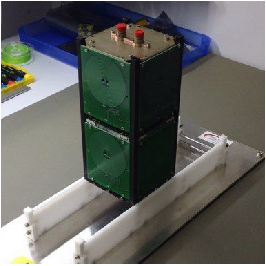Russian nanosatellite SamSat-QB50, which is being created by the scientists of Samara State Aerospace University (SSAU) within the framework of the international project QB50, will be launched in 2016 from the Japanese module Kibo of the International Space Station (ISS). The exact launch date and a carrier for the delivery of over 40 nanosatellites to the ISS for QB50 project will be determined by the company NanoRacks, which has signed a contract for launch services with a project manager from Von Karman Institute for Fluid Dynamics.
SSAU became the only Russian university that participates in the European project QB50. Its fundamental task is the construction and study of a space-time model of the Earth thermosphere. The first two nanosatellites, designed to test the scientific instruments were launched two years ago. Another six nanosatellites should be launched by the Russian conversion carrier rocket “Dnepr” in August this year. These are the satellites, which construction and scientific equipment cannot be delivered to the ISS for security reasons. A major launch campaign for the rest of nanosatellites, designed by the leading world universities for this project will begin on 1 July. Samara nanosatellite SamSat-QB50 will also be among them.
Presently, the scientists of SSAU Inter-University Department of Space Research install on SamSat-QB50 a complex of scientific equipment FIPEX, created by the Dresden University of Technology and designed to register formation and decomposition of atomic oxygen in the near-Earth space. In addition, the University experts prepare the necessary documents, including the testing results of individual subsystems and all the whole satellite, which will be reviewed by a special commission on placing payloads on board the ISS, for launch permissions of the Russian nanosatellite using a separating system NanoRacks installed on the pointing device of the Japanese module Kibo. “It is a new and extremely serious challenge for us, as there are certain rules of all the works in terms of safety of the International Space Station, which is very tightly controlled”,- noted Professor Igor Belokonov, Head of SSAU Inter-University Department of Space Research.
In addition, SSAU scientists have been working on the improvement of the launch reliability for the created nanosatellite. Launching of the international constellation will be performed from the module Kibo. ISS assumes that CubeSats will be launched from the special “tubes” with a spring system, as if pushing each other –three “double” satellites at the same time from each “tube”. Thus such a system imposes additional requirements for the device design reliability and the safety of scientific equipment contained therein, as well as the protection of the launching module itself. For example, a scarcement or opening elements of design may prevent the exit of the nanosatellite – it may stick and will not let another CubeSats go out. This will make a contingency that should be solved by the station crew.
In order to avoid such a situation, Russian scientists have made changes to the original design of the device. “As for the alterable geometry and sliding design of our satellite, we have made changes and aerodynamic stabilizer will be disclosed without boosting due to the spring. We reworked the design to improve the launch reliability of our nanosatellite to the ISS”,- underlined Igor Belokonov.
Initially SamSat-QB50 has the form of a “double” CubeSat, and after reaching the orbit it expands and takes the form of a “triple” cube. This allows using aerodynamic force that acts at these altitudes, in order to stabilize the roll axis of the airspeed vector. The Russian nanosatellite will start operating at approximately the same orbit as the ISS at an altitude of 430 - 380 km from the Earth.
For reference
QB50 project is being implemented under the auspices of the Von Karman Institute for Fluid Dynamics (Belgium) since 2009. The task of the international group of 50 nanosatellites is the construction and study of a space-time model of the Earth thermosphere - the lower layers of the upper atmosphere. In this regard all the satellites of the project QB50 will carry a standardized set of sensors for measuring of the key parameters and the composition of the lower thermosphere and ionosphere. The information received by several satellites simultaneously with an identical set of sensors will have a fundamental scientific value. Such information cannot be obtained in other ways.
The project is also unique because only the leading world universities participate herein on space subjects - 37 universities from over 20 countries. The largest numbers of satellites in the project are made by China – 7, France – 5, USA - 4. Samara State Aerospace University is the only Russian participant in the mission which won the competition and included into QB50.
 RU
RU  EN
EN  CN
CN  ES
ES 